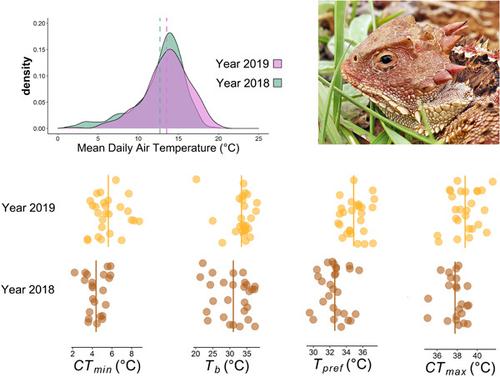当前位置:
X-MOL 学术
›
J. Exp. Zool. Part A
›
论文详情
Our official English website, www.x-mol.net, welcomes your feedback! (Note: you will need to create a separate account there.)
Thermal physiology responds to interannual temperature shifts in a montane horned lizard, Phrynosoma orbiculare
Journal of Experimental Zoology Part A ( IF 2.8 ) Pub Date : 2020-08-06 , DOI: 10.1002/jez.2403 Saúl F Domínguez-Guerrero 1, 2, 3 , Brooke L Bodensteiner 1 , Alexis Pardo-Ramírez 4 , David R Aguillón-Gutierrez 5 , Fausto R Méndez-de la Cruz 2 , Martha M Muñoz 1
Journal of Experimental Zoology Part A ( IF 2.8 ) Pub Date : 2020-08-06 , DOI: 10.1002/jez.2403 Saúl F Domínguez-Guerrero 1, 2, 3 , Brooke L Bodensteiner 1 , Alexis Pardo-Ramírez 4 , David R Aguillón-Gutierrez 5 , Fausto R Méndez-de la Cruz 2 , Martha M Muñoz 1
Affiliation

|
As climate change marches on, rapidly rising temperatures shatter records every year, presenting ever‐growing physiological challenges to organisms worldwide. Ectotherms rely on behavioral and physiological plasticity to contend with environmental fluctuations. Nonetheless, our understanding of thermal plasticity has been largely limited to laboratory settings. Here, we test whether aspects of thermal physiology respond to interannual shifts in thermal environment in a natural population of Phrynosoma orbiculare, a montane horned lizard, from Hidalgo, Mexico. At our field site, 2019 was markedly warmer than the year that preceded it. We detected population‐level increases in three key thermal physiological traits: preferred temperature, the critical thermal minimum, and the critical thermal maximum. Thus, thermal phenotypes appear to shift in tandem in response to environmental fluctuations. A subset of individuals were resampled across years, allowing insight into plastic shifts within an organism's lifetime. We detected parallel increases in these lizards for the preferred temperature and the critical thermal minimum, but not for the critical thermal maximum. Our results support a growing body of literature indicating that preferred conditions and cold tolerance can be highly labile over the course of an organism's lifetime, whereas hardening over shorter time periods is more common for heat tolerance. Given that heat tolerance increased at the population‐level, but not in resampled individuals, it is possible that rapid evolution occurred due to temperature increases. In short, physiological shifts can be observed in natural populations over relatively short timespans, and these shifts might reflect a combination of evolutionary and acclimatory responses.
中文翻译:

热生理学对山角蜥蜴,球菌Phrynosoma orbiculare中的年际温度变化作出响应
随着气候变化的发展,每年迅速升高的温度打破了记录,对全世界的生物提出了日益增长的生理挑战。放热依靠行为和生理可塑性来应对环境波动。但是,我们对热可塑性的理解主要限于实验室环境。在这里,我们测试了自然圆球菌的热生理方面是否响应热环境的年际变化。,来自墨西哥伊达尔戈的山地有角蜥蜴。在我们的现场工作中,2019年明显比前一年温暖。我们在三个关键的热生理特征中检测到了人口水平的增加:首选温度,临界热最小和临界热最大。因此,热表型似乎响应环境波动而串联移动。多年来,对一部分个体进行了重新采样,从而可以洞悉有机体生命周期内的塑性变化。我们检测到这些蜥蜴在最佳温度和临界热最小值上平行增加,但对于临界热最大值却没有。我们的研究结果支持了越来越多的文献,这些文献表明,优选条件和耐寒性在生物体的整个生命过程中可能非常不稳定,而在较短的时间内硬化对于耐热性则更为常见。鉴于耐热性在总体水平上有所提高,但在重新采样的个体中并未提高,因此可能由于温度升高而发生了快速进化。简而言之,可以在相对较短的时间跨度内在自然种群中观察到生理变化,这些变化可能反映了进化和适应性反应的结合。
更新日期:2020-08-06
中文翻译:

热生理学对山角蜥蜴,球菌Phrynosoma orbiculare中的年际温度变化作出响应
随着气候变化的发展,每年迅速升高的温度打破了记录,对全世界的生物提出了日益增长的生理挑战。放热依靠行为和生理可塑性来应对环境波动。但是,我们对热可塑性的理解主要限于实验室环境。在这里,我们测试了自然圆球菌的热生理方面是否响应热环境的年际变化。,来自墨西哥伊达尔戈的山地有角蜥蜴。在我们的现场工作中,2019年明显比前一年温暖。我们在三个关键的热生理特征中检测到了人口水平的增加:首选温度,临界热最小和临界热最大。因此,热表型似乎响应环境波动而串联移动。多年来,对一部分个体进行了重新采样,从而可以洞悉有机体生命周期内的塑性变化。我们检测到这些蜥蜴在最佳温度和临界热最小值上平行增加,但对于临界热最大值却没有。我们的研究结果支持了越来越多的文献,这些文献表明,优选条件和耐寒性在生物体的整个生命过程中可能非常不稳定,而在较短的时间内硬化对于耐热性则更为常见。鉴于耐热性在总体水平上有所提高,但在重新采样的个体中并未提高,因此可能由于温度升高而发生了快速进化。简而言之,可以在相对较短的时间跨度内在自然种群中观察到生理变化,这些变化可能反映了进化和适应性反应的结合。



























 京公网安备 11010802027423号
京公网安备 11010802027423号